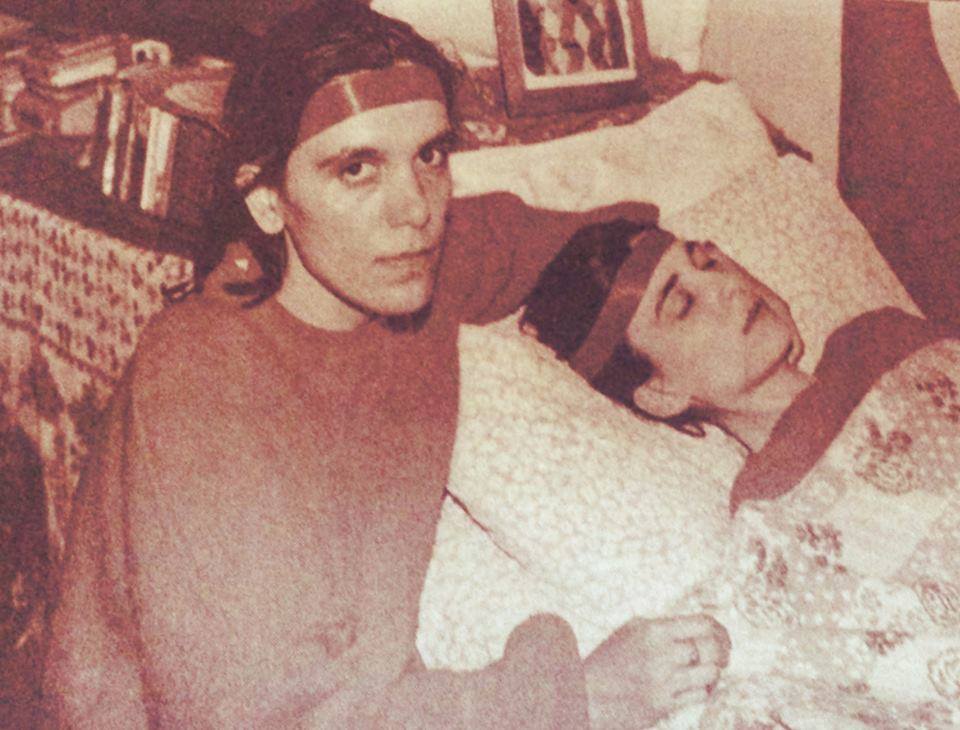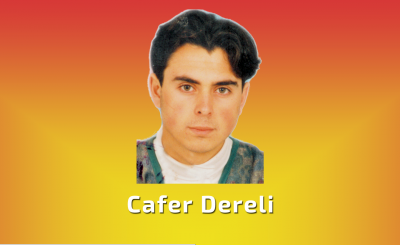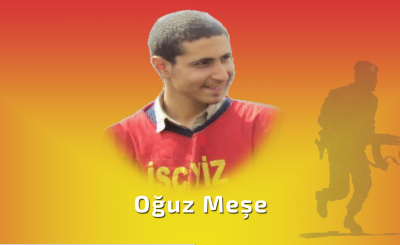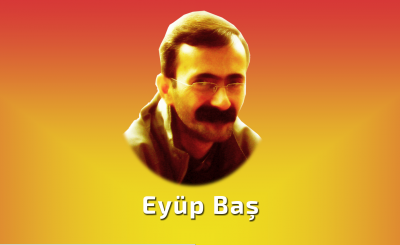It has been a difficult battle. This phase of the war was to become the theatre of a remorseless retribution. Like hundreds of her comrades, she stood up and took her place in the front lines. “I ‘ll be part of this too, in this battle I want to fight in the front lines,” she said. But she was different from the ‘majority. She was a woman. Another difference: she was also an artist.
At the end of the remorseless battle, this retribution with the oligarchy, Ayse Idil Erkmen received the honour of being the first women to fall in the hunger strike till death. She became the first female hero of a war in which death was defeated slowly and painfully.
She is the first artist who fell in such an open fight against the enemy. Idil, the artist. Idil, the woman. Idil, the revolutionary. Idil, member of the Party-Front… Should we ask ourselves, like the others, which one of those characteristics is the decisive one? To ask this question, or to answer it in one way or the other, means not understanding why she fell.
IDIL, THE WOMAN.

For centuries, women participated in the revolutionary struggle. But, depending on the time and the society women lived in, there were differences in the way they participated in the struggle. We don’t’ want to initiate a discussion here about the theme of ‘Women in the Revolution”. But nobody should neglect the fact that women like Ayse Gülen and Idil carry on the heritage of Rosa Luxemburg, Clara Zetkin and Tanja (Tamara Haydee) into our era. The intellectuals in our country are known for their double standards. While they honour the Intifada of the Palestinian people, they ignore the liberation struggle by their one people, a struggle which is fought in front of their own eyes. While they write poems for Leyla Halit, they ignore those who fight with a weapon in their hand. They hang the poems by Rosa and Tanja on the walls of their bedrooms and disregard Ayse Gülen. If the intellectuals want to surpass their blindness and double standards, they first have to understand that women like Idil are the links in a chain which links the century old struggle of the women, the heroic, wise and sacrificing women in the revolutionary struggle, with our era. Until the seventies, the participation of the women in the revolutionary struggle in our country always had been a theoretical one. Besides a few exceptions, those women who participated in the socialist movement were from the scene of the petite bourgeois intellectuals, corresponding with the overall characteristics of the movement. In 1970, this changed. Now more women were participating in the occupation of land and the universities. Now they were in the midst of the confrontations with the police and the gendarmes as well. This constituted a change in their identity. This phase developed further until the eighties. However, the development still was far away from the objective. Besides a few exceptions, the women still played secondary roles in the revolution. The role which was designated for women by the bourgeois and feudal culture, was not yet surmounted by the revolutionary movement. But the way was cleared.
The real and major development occurred after 1980. The woman, resisting torture, resisting in front of the prisons, constituted the avant-garde of the major junction to the revolutionary struggle.
Those who wanted to terrify society in every aspect, used the ideological attack, as well as terror. While women constituted almost half, and sometimes even the majority, of the protesters, it was tried to poison the women’s front with a bourgeois movement: feminism. This poison has had its effect in certain circles, and even in some revolutionary movements.
Expressions like women’s identity and women’s liberation became incomprehensible. But this could not stop the revolutionary development of women, a development which was expressed by women like Sabo, Eda, Haiyet, Olcay, Sibel, Ayse Gülen, Esma, Adalet and Gülizar. With their struggle, their courage and their willingness to sacrifice, they ended all misconception about women. They promoted the development towards revolutionary and the liberation of women rapidly.
That women participated in the hunger strike till death, and one of them fell in this battle, is an important element in the history development. Idil proofed unequivocally who can defend and represent the liberation and identity of women.
The true face of those who claim that only they defend the identity and the rights of the woman has been clearly shown once again. Where was the ‘Women Commission” of the ÖDP (Party for Freedom and Solidarity) who have written for months about ‘women rights” and who declared ‘war against men”? Where were the ‘Pink Needles” (1)? Where were the feminists of the Monday groups? They didn’t support Idil’s resistance and they weren’t present at her funeral. Idil was a woman who fought for freedom and her fight is proof that the struggle for freedom is not a men’s case. Where were you? Isn’t it proof for the strength of the woman when she proofs the lack of will and weakness of bourgeois ideology by defeating death cell by cell? Where were you in this fight which established the dignity of women? In your eyes the rights of women are limited to ‘free sexuality’ and ‘artificial equality’. The rights of women also means deciding as well about the future of the country. This is the line which was represented by Sabo till Idil and which was put into practice. Yes, they determine, together with the men and with equal rights, shoulder to shoulder, the future of this country. Without participating in such a struggle, women can neither defend their rights, nor liberate their identity which is trampled by feudalism and the bourgeois. Those who propose a way outside of this struggle for the defence of the rights and the liberation of women are swindlers. Is it possible to defend women’s rights, just by ‘needle actions’? By proclaiming press statements in brothels? Can they be removed without fighting against the regime which makes these brothels possible in the first place? Where were those who marched for the tranvestites in Beyoglu, who gave a show for the press with their needles, when the mothers of the disappeared and the prisoners were beaten up, every week again, by the police? Are these mothers no women? Where were you when dozens of women went towards death in the hunger strike till death? Are they not women when they fight against the regime in the hunger strike till death? You didn’t really take them as your sisters or children and it should be discussed whether you possess sisterly or motherly feelings at all. You didn’t take them as your fellow women, your comrades. Whether you possess female feelings at all should be discussed.
Women and girls of our country: when you want to liberate yourselves from a system which condemns you to be ‘second class people’, and exploits you as sexual commodities, then women and girls like Sabo, Hamiyet, Esma, Olcay, Sibel and Idil are your true models.
(1) A feminist group which attacks men with pink needles to show women ways for self-defence.
IDIL, THE ARTIST
 She was an artist, a musician, a gifted actress and writer. But what do these words alone say? The meaning and the function of her work can not be valued without explaining what kind of songs she sang, what theatre plays she played, what kind of texts she wrote. She was an artist of the struggle. She sang the songs of our people and in these songs, in the plays, in the texts, she practised the art of the struggle.
She was an artist, a musician, a gifted actress and writer. But what do these words alone say? The meaning and the function of her work can not be valued without explaining what kind of songs she sang, what theatre plays she played, what kind of texts she wrote. She was an artist of the struggle. She sang the songs of our people and in these songs, in the plays, in the texts, she practised the art of the struggle.
In our country the artist have always proclaimed the ‘Theory of the independence from organisations’. The examples of practice have shown they were wrong, that they are still wrong. But they still defend the position that an organisation would ‘kill their creativity’. Idil’s artistic creativity developed parallel to her development in the struggle, her development as a revolutionary.
Was she primarily a revolutionary or an artist? This false dilemma, where the petite bourgeois intellectuals are in, is rendered void by the tradition which goes from Ayse Gülen to Idil. This dilemma resembles a new stream which has not found its bed yet, which doesn’t know to flow to the right or to the left, which flows without direction. Revolutionary artists have found their way, they are artists who know their goal. For them it is impossible to separate being a revolutionary and an artist, for them there is no contradiction. They are not saying: ‘first this, then that’. Being is revolutionary is a paramount characteristic which determines the entire life of a human. Organisation is no hindrance for artists, it is a power. Party-Front artists create because life in the Party-Front is a well of creativity for artists which never dries up. Artists who materialise the culture of the Party-Front become its focus and they can always take from it for their material and immaterial needs. In this tradition from Ayse Gülen to Idil, Grup Yorum, Grup Ekin and the Ayse Gülen People’s Theatre ripened and the line of organised art had developed further, it’s the line of revolutionary art. To develop this line from where it is now, is the answer to some abstract debates. For those who haven’t understood, haven’t seen until now, Idil should be an example to learn from.. The fact that she took her place in this bitter war also shows she wasn’t a sensitive artists without political identity. The sensitivity of an artist alone is not enough to take a place in such a heroic struggle. What is needed is the totality of revolutionary sensibility, the responsibility towards the people and the revolution.
IDIL OF THE PARTY-FRONT
 In the Revolutionary People’s Liberation Party-Front there is no discussion about the role of women. The women ended this discussion with the struggle they fought. They have ended this discussion by not fighting against men, but fighting against the oligarchy. The revolutionary women fought their way, paying the price, form the ‘back front’ to the first front. Women are no longer just carrying the depot, they are carrying weapons and they use them. They are not just following directives, they give orders. They not only read, they write. They fight against the role which is forced upon them by the ideology of feudal and bourgeois culture, against the oppression in society and it’s limiting conditions. They successfully tear down the obstacles, put in their way because of the feudal ideas of men in the struggle. Women were in the first front of the struggle in the DHKP-C, they were in the forefront of the structures of the organisation, and that is where they are today as well. All doors are open for a fighting woman, fighting for the freedom of her people, and thus for the freedom of women. To discuss women rights, strength and weaknesses of women etcetera in the organisation is backward and pointless. In the revolutionary struggle ‘positive discrimination’ like ‘women’s quota’ would be institutionalising the weakness of women. This would mean: ‘You are not taking your place on your own strength and will’. Women have their places inside the DHKP-C. The problem is not ‘filling quota’, the problem is filling the ranks in the struggle against the oligarchy. Women have done this, they have been successful.
In the Revolutionary People’s Liberation Party-Front there is no discussion about the role of women. The women ended this discussion with the struggle they fought. They have ended this discussion by not fighting against men, but fighting against the oligarchy. The revolutionary women fought their way, paying the price, form the ‘back front’ to the first front. Women are no longer just carrying the depot, they are carrying weapons and they use them. They are not just following directives, they give orders. They not only read, they write. They fight against the role which is forced upon them by the ideology of feudal and bourgeois culture, against the oppression in society and it’s limiting conditions. They successfully tear down the obstacles, put in their way because of the feudal ideas of men in the struggle. Women were in the first front of the struggle in the DHKP-C, they were in the forefront of the structures of the organisation, and that is where they are today as well. All doors are open for a fighting woman, fighting for the freedom of her people, and thus for the freedom of women. To discuss women rights, strength and weaknesses of women etcetera in the organisation is backward and pointless. In the revolutionary struggle ‘positive discrimination’ like ‘women’s quota’ would be institutionalising the weakness of women. This would mean: ‘You are not taking your place on your own strength and will’. Women have their places inside the DHKP-C. The problem is not ‘filling quota’, the problem is filling the ranks in the struggle against the oligarchy. Women have done this, they have been successful.
IS IDIL AN EXCEPTION?
 Idil was not an exception, her attitude was the result of a historical development of women in the ranks of the DHKP-C. Women conquered their places by struggle. Maybe it’s not possible to make clear how many women fight in what way on the outside. But for those who do not know about the development, we can point to the women in prison, to the women who fell for their dignity and honour. When you look at the number of women of the DHKP-C (Devrimci Sol) in prison, as well as the number of women who fell, in the time of the coup of September 12, 1980, and compare them with the numbers of today, you can see the incredible development. Dozens and dozens of our women fighters fell in the resistance. They have written their names in blood in our history, selfless and willing to sacrifice. This is not a history which is only written guerrilla fighters, commanders and fighters. Look at the surpassing of the process of de-politicing, the surpassing of the darkness form the time of the military coup. Look, in the front ranks there have always been women.
Idil was not an exception, her attitude was the result of a historical development of women in the ranks of the DHKP-C. Women conquered their places by struggle. Maybe it’s not possible to make clear how many women fight in what way on the outside. But for those who do not know about the development, we can point to the women in prison, to the women who fell for their dignity and honour. When you look at the number of women of the DHKP-C (Devrimci Sol) in prison, as well as the number of women who fell, in the time of the coup of September 12, 1980, and compare them with the numbers of today, you can see the incredible development. Dozens and dozens of our women fighters fell in the resistance. They have written their names in blood in our history, selfless and willing to sacrifice. This is not a history which is only written guerrilla fighters, commanders and fighters. Look at the surpassing of the process of de-politicing, the surpassing of the darkness form the time of the military coup. Look, in the front ranks there have always been women.
One can not ignore history and when one does not watch history closely, one can not understand all the Sibel’s. the Ayse Gülen’s and the Idil’s. Then one can not understand why this development has reached such a quality, in the first place in the ranks of the DHKP-C.
The revolution in itself is an art. With politics alone, with military strength alone, nothing can be won. Only when we proceed day by day, from struggle to struggle, with artistic sensitivity as well, can we achieve victory. Only then can we complete the painting. And the perfection and completion of this painting is done by women and men, hand in hand. The DHKP-C does not fight with an abstract theory, it is an organisation which fights with a revolutionary spirit, with a revolutionary sensibility. Carrying on the tradition is not done without reason. To be the first ones who create something, is not without reason. In the way we fight, we recite our poems, in the way we recite our poems, we fight. Our women, our men, together they work at the paste of the revolution. This is the well courage stems from.
WOMEN AND ARTISTS OF OUR COUNTRY:

Now is the time to become like Idil. Becoming like Idil means liberation as a woman. Becoming like Idil means climbing the top of art. Idil, she is the honour of our women in the schools. She rejected to walk behind men, weak, without will, fragile. She walked next to men. Being like her, means liberation, means determine life yourself. Idil, she is the honour of the artists who write their songs for the people, who paint their paintings for the people. Her last song, her last play – the hunger strike till death – can not be played without being like Idil. Her name will become the symbol of trust by our people in the artists. In the eyes of our people all artists will gain meaning, value, with her. Now is the time to be like Idil. Now is the time to sing our songs like Idil. To be a woman like Idil.




